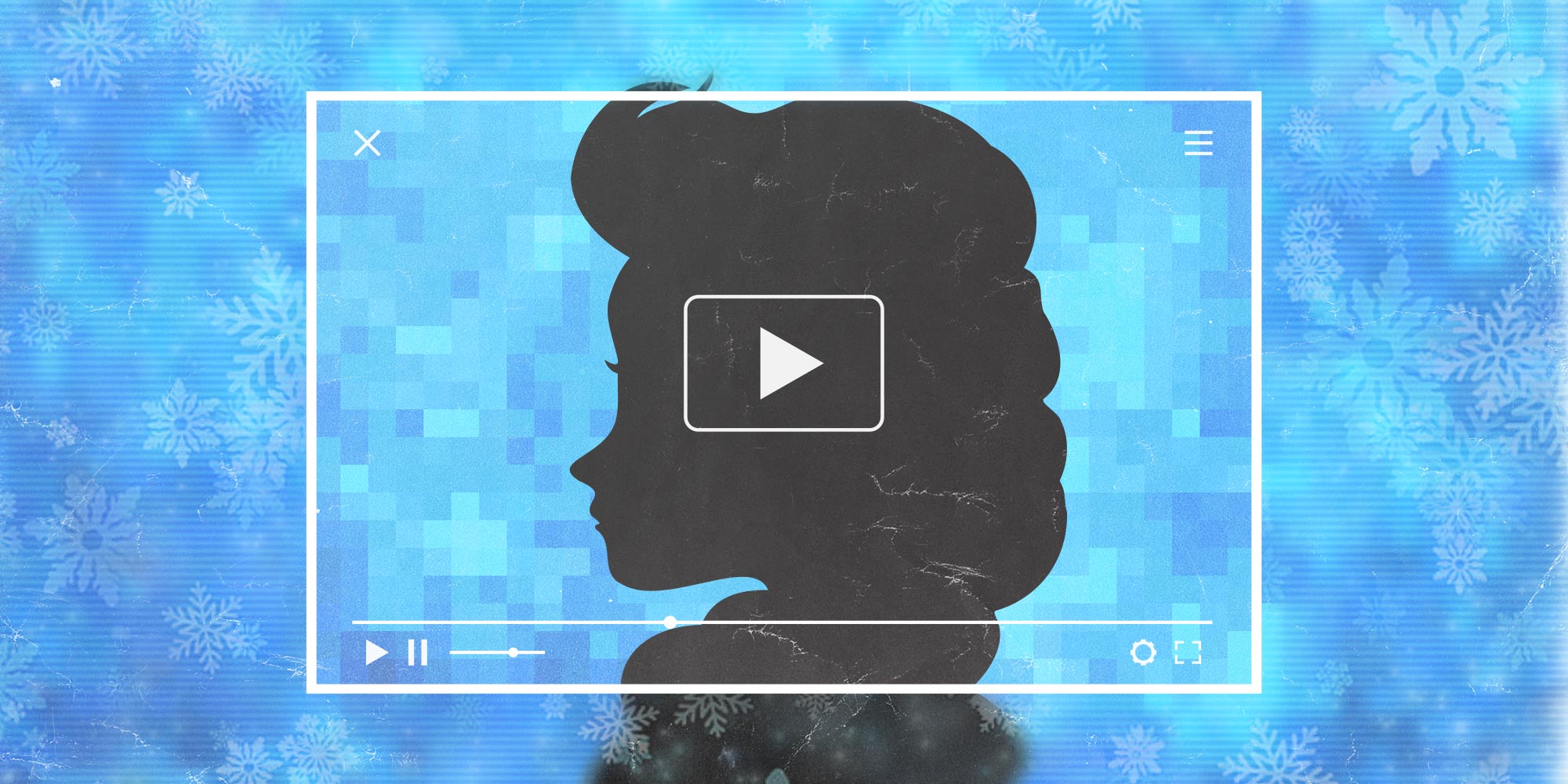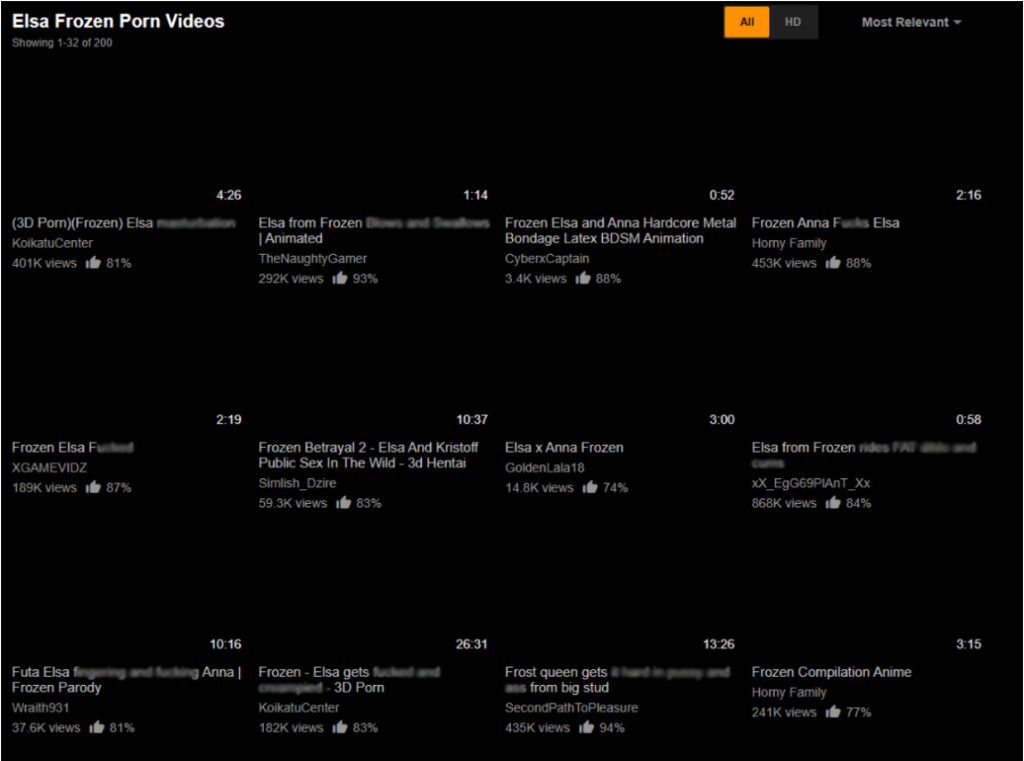This article was originally shared by the National Center on Sexual Exploitation and is reposted with permission. It has been edited for length.
Note: Angelina is not a real person but a likely story based on the findings of research.
When Angelina first watched the Disney movie Frozen, she promptly became obsessed. For the next several months, little Angelina could constantly be found toddling about the house, singing “Let it gooooo” at the top of her lungs.
Brave and beautiful Elsa became Angelina’s idol. On Halloween, Angelina donned an Elsa costume. When she turned 6 years old, she had an Elsa-themed birthday party. At school, she invariably spent her recesses playing “Elsa and Anna” with her best friend Carlie. (Angelina was always Elsa. Carlie was Anna.)
One day, Angelina was on her mother’s iPad. She was allowed to use the device to entertain herself while her parents were busy cooking dinner or working.
With her tiny thumbs, Angelina typed “Elsa” into the search bar.
For the next twenty minutes or so, she swiped happily through the videos and songs, and images of her well-beloved Frost Queen.
Then, Angelina arrived at a video titled “Frozen Elsa and Anna Hardcore BDSM.”
She clicked on it…
We don’t need to go further into what Angelina would have seen that day. The above image depicts the first page of results when NCOSE researchers typed the words “Elsa Frozen” into Pornhub. For your protection, NCOSE blocked all thumbnails and blurred explicit language. But girls like Angelina would not have enjoyed such protection.
The disturbing reality is that cartoon pornography, often depicting characters from mainstream children’s shows, is more prevalent than you might think. And new research suggests this subset of pornography is apt for drawing in young children like Angelina.
The prevalence of cartoon pornography exposure among young children
Cartoon Pornography is not an issue that is on many parents’ radar—even those parents who are aware of the threat of “regular” pornography (i.e., photographic pornography). However, recent research from the British Board of Film Classification demonstrates that the risk of children being exposed to cartoon pornography is not at all negligible.
This BBFC study analyzed the top 100 pornography sites visited by children aged 6-12 in the UK. Eight of these sites were cam sites and consequently excluded from the study. Of the remaining 22 sites, 50% specialized in animated or drawn pornography—referred to in the report as “non-photographic pornography.”
A recent study found that a significant percentage of the pornography viewed by young children is “cartoon” pornography. 50% of the top 100 non-cam pornography sites visited by children aged 6-12 specialized in animated/drawn pornography.
Children aged 6-12 disproportionately visited sites specializing in non-photographic pornography compared to groups that included older participants. For children aged 6-17, 21% of the top 30 pornography sites (excluding 6 cam sites) specialized in non-photographic pornography, and none of the top 30 sites specialized in non-photographic pornography when the sample included adults.
One possible explanation for these statistics is that cartoon pornography exposure could be serving as a “gateway” to photographic pornography consumption, with many young children starting out watching non-photographic pornography and later transitioning to photographic pornography.
It is important to note that, while the above statistics only take into account sites that specialize in cartoon pornography, this content is also very commonly consumed even on pornography sites that do not specialize in it. For example, in 2022, Pornhub’s #1 most searched term worldwide was “hentai”. Hentai is cartoon pornography that has a Japanese art style, like the art style of anime and manga.
Cartoon pornography features characters from popular children’s shows
A particularly disturbing subset of cartoon pornography is content that features characters from popular children’s shows—such as the “Elsa” pornography shown in the opening anecdote. Featuring mainstream cartoon characters is likely to increase the chance that the pornography will catch the eye of young children and that children will be accidentally exposed while conducting innocuous Google searches related to their favorite movies and tv shows.
The BBFC research found that 48.2% of the top 100 sites visited across all ages (excluding 17 cam sites) carried content featuring characters that were likely to be familiar/appealing to children. For example, the researchers found numerous pornography titles related to characters from Frozen, Tangled, Scooby Doo, The Incredibles, Pokémon, and more.
When NCOSE researchers searched for similar titles on Pornhub, we found much of the same, plus numerous titles related to classic Disney films, such as The Little Mermaid, Beauty and the Beast, Aladdin, Peter Pan, etc.
Mainstream pornography sites carry content featuring characters from popular children’s shows—e.g. Anna and Elsa from Frozen. This seems specifically designed to prey on children and draw them into the destructive habit of pornography use.
And this content is far from child friendly. Of course, no pornography is or should be intended for children. But even further than that, the BBFC noted finding content that was particularly harmful in terms of “promoting an interest in abusive relationships.” The study highlighted numerous video titles featuring themes of rape, incest, physical aggression, and more.
This mirrors research on photographic pornography. For example, a 2021 study found that one in eight video titles presented to first-time viewers of three mainstream pornography websites described sexual violence involving incest, physical aggression and sexual assault, and non-consent.
It is nothing short of a crisis that our children are being exposed to this content that normalizes violence and abuse.
Cartoon child sexual abuse material
To make matters worse, a significant amount of cartoon pornography is actually cartoon child sexual abuse material (CSAM, the more apt term for “child pornography”).
The researchers behind the BBFC study actually took precautions to avoid finding cartoon/non-photographic CSAM, as it is an offense to possess this material under UK law. However, even while taking these precautions, the study found that 65.1% of the non-cam sites in the top 100 pornography sites visited across all ages carried, among their most prominent content, non-photographic content that the title and/or thumbnail suggested may feature child or child-like characters. This percentage is likely a gross underestimate, considering the researchers specifically strove to avoid this content.
The BBFC researchers also interviewed a panel of experts about their assessment of the harms of this type of material. The majority of the expert panelists expressed concern that people who view non-photographic child sexual abuse material may escalate to viewing photographic child sexual abuse material or even eventually commit contact sex offenses against children. The experts argued that this may happen due to “the normalization of attitudes to the material and its sexual arousal potential.” In other words, even though non-photographic CSAM is not victimizing a real child, it is training the viewer to see children as a subject of sexual interest and is desensitizing them to the crimes of contact child sexual abuse and/or consumption of photographic CSAM.
The risks and harms
As part of their research, the BBFC conducted a literature review, as well as several interviews with experts, to assess the potential harms related to non-photographic pornography. Their analysis suggested the following risks, among others:
- the first sexual images seen by children can include abusive imagery contained within hentai (Japanese-style cartoon pornography)
- non-photographic pornography can be used in the sexual grooming of children
- attitudes supportive of violence toward others, such as coercive and degrading acts toward women depicted in certain types of non-photographic pornography, can lead to the objectification and abuse of women
- children want to try out things seen in pornography and other sexually explicit material and sexually abusive material
Other research on pornography in general has uncovered a myriad of harms to children, including an increased risk of being sexually exploited, increased risk of committing sexual violence, increased mental health problems, poor academic achievement, and more.
About the Author
Lily Moric is the Communications & Campaigns Specialist for the National Center on Sexual Exploitation. She is also an independent educator on the harms of pornography. Lily’s work on pornography first began in university, when she founded the initiative Questioning Pornography. Under Questioning Pornography, Lily hosted a podcast, organized webinars, coordinated campus activism, facilitated discussion groups, and more. Lily also regularly presents in high schools, helping young people understand the risks pornography poses to their sexual and relational health, as well as the ways pornography fuels sexual violence and abuse.
Your Support Matters Now More Than Ever
Most kids today are exposed to porn by the age of 12. By the time they’re teenagers, 75% of boys and 70% of girls have already viewed itRobb, M.B., & Mann, S. (2023). Teens and pornography. San Francisco, CA: Common Sense.Copy —often before they’ve had a single healthy conversation about it.
Even more concerning: over half of boys and nearly 40% of girls believe porn is a realistic depiction of sexMartellozzo, E., Monaghan, A., Adler, J. R., Davidson, J., Leyva, R., & Horvath, M. A. H. (2016). “I wasn’t sure it was normal to watch it”: A quantitative and qualitative examination of the impact of online pornography on the values, attitudes, beliefs and behaviours of children and young people. Middlesex University, NSPCC, & Office of the Children’s Commissioner.Copy . And among teens who have seen porn, more than 79% of teens use it to learn how to have sexRobb, M.B., & Mann, S. (2023). Teens and pornography. San Francisco, CA: Common Sense.Copy . That means millions of young people are getting sex ed from violent, degrading content, which becomes their baseline understanding of intimacy. Out of the most popular porn, 33%-88% of videos contain physical aggression and nonconsensual violence-related themesFritz, N., Malic, V., Paul, B., & Zhou, Y. (2020). A descriptive analysis of the types, targets, and relative frequency of aggression in mainstream pornography. Archives of Sexual Behavior, 49(8), 3041-3053. doi:10.1007/s10508-020-01773-0Copy Bridges et al., 2010, “Aggression and Sexual Behavior in Best-Selling Pornography Videos: A Content Analysis,” Violence Against Women.Copy .
From increasing rates of loneliness, depression, and self-doubt, to distorted views of sex, reduced relationship satisfaction, and riskier sexual behavior among teens, porn is impacting individuals, relationships, and society worldwideFight the New Drug. (2024, May). Get the Facts (Series of web articles). Fight the New Drug.Copy .
This is why Fight the New Drug exists—but we can’t do it without you.
Your donation directly fuels the creation of new educational resources, including our awareness-raising videos, podcasts, research-driven articles, engaging school presentations, and digital tools that reach youth where they are: online and in school. It equips individuals, parents, educators, and youth with trustworthy resources to start the conversation.
Will you join us? We’re grateful for whatever you can give—but a recurring donation makes the biggest difference. Every dollar directly supports our vital work, and every individual we reach decreases sexual exploitation. Let’s fight for real love:





